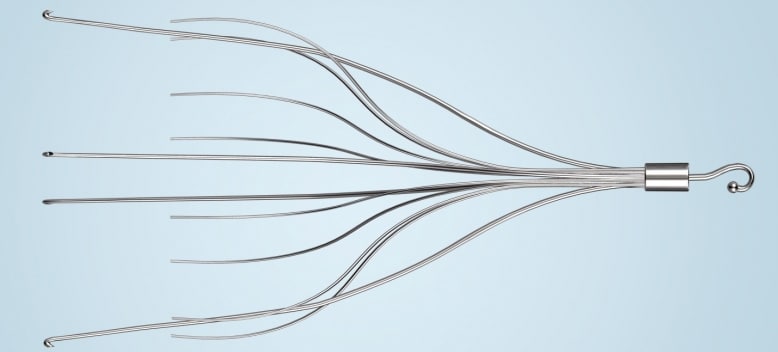The lawsuit was filed by Christina P., a woman from Ohio who was implanted with the Cook Celect® Vena Cava Filter on February 10, 2010 at UH Main Hospital in Cincinnati.
Celect is an intravenous filter that is implanted in a vein called the inferior vena cava (IVC), where it stops blood clots in the bloodstream before they hit the lungs or cause a pulmonary embolism.
Cook Celect IVC Filter
It was introduced in 2007 as a new-and-improved version of the Cook Gunther Tulip, an older IVC filter that had tilting issues. Cook tried to fix this problem on the Celect by adding four “unprotected primary struts” — in other words, needle-like metal legs that dig into the vein and anchor Celect in place.
Those design changes reduced tilting, but dramatically increased the rate of vein perforation in the first 90 days. In 2007, a study blamed the unprotected primary strut design on an unexpectedly risk of early vein perforations.
Celect was linked to a 39% risk of vein perforation in the first 30 days, and an 80% risk within 90 days, according to a study of 690 patients that was published in 2014. Penetration into adjacent organs (e.g., duodenum, aorta, psoas muscle) occurred in 13.2% of patients.
In another study of 115 patients, 86% of Celect filters perforated the vein within 5 months, on average. The researchers warned:
Penetration appears to correlate with indwelling time, suggesting that the filter should be removed as soon as [Pulmonary Embolism] protection is no longer indicated. Although most of the filters were removed, 5.8% of retrievals were unsuccessful.”
Vein perforations do not usually cause symptoms unless the struts poke into a nearby organ, which is one reason why patients often delay removing the filter until it is too late. Once the filter perforates the vein, it is more difficult to remove — or sometimes impossible.
Leaving a “short-term” IVC filter like the Celect implanted forever is not safe, or an effective way to protect patients from blood clots. Ironically, blood clots in the legs (IVC thrombosis) are a common long-term side effect due to IVC filters slowing down blood circulation.
This is why the FDA recommends removing “short-term” IVC filters as soon as the patient’s risk of blood clots has passed, or as soon as the patient can take a blood-thinning medication instead — ideally within 29 and 54 days post-implant. Even so, fewer than 30% are ever removed.
Cook Medical is accused of downplaying side effects and continuing to sell a medical device with a dangerously defective design.
The lawsuit was filed on February 21, 2017 in the U.S. District Court for the Southern District of Indiana (Indianapolis Division) — Case No. 1:17-cv-00543.
It will be centralized with around 1,500 other IVC filter lawsuits now pending in Multi-District Litigation (MDL No. 2570) — In Re: Cook Medical, Inc., IVC Filters Marketing, Sales Practices, and Products Liability Litigation.
The plaintiff is represented by Ben C. Martin and Thomas Wm. Arbon of The Law Offices of Ben C. Martin.
Ben C. Martin is a trial attorney based in Dallas, Texas who serves as the plaintiffs’ co-lead counsel in the Cook IVC Filter MDL.
